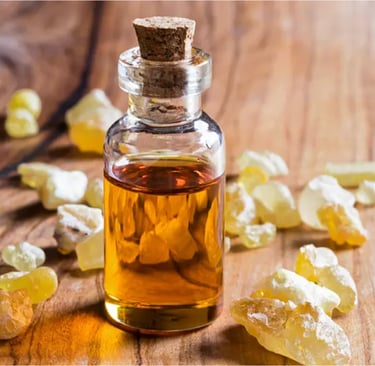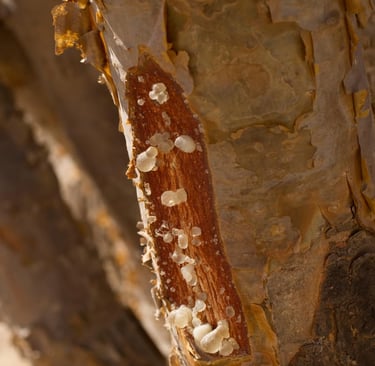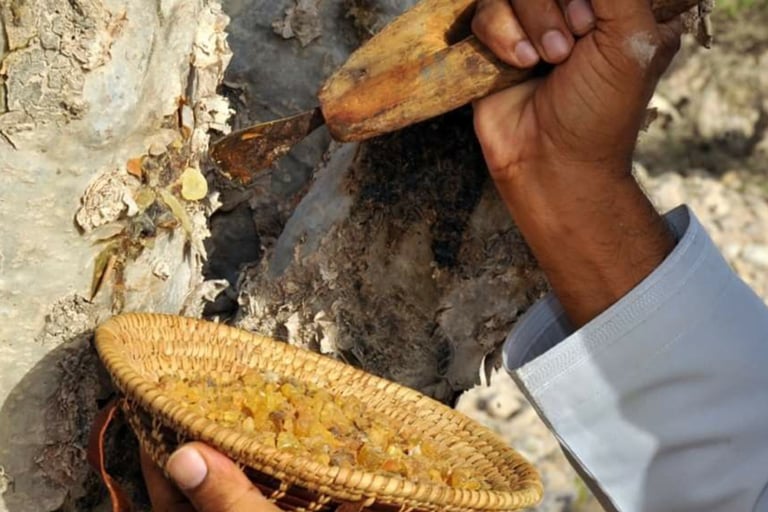Frankincense and the Spiritual Heart — A Bridge Between Traditional Chinese Medicine & Islamic Medicine
Across ancient civilizations, frankincense was more than a fragrance; it was a bridge between the human and the divine. Used in beauty rituals, perfumes, and healing balms, it soothed both body, soul, and heart.
11/12/20252 min read


Frankincense in Traditional Chinese Medicine
Frankincense — known as Ru Xiang (乳香) in Traditional Chinese Medicine. It carries the essence of desert warmth and divine fragrance. Traded along the ancient Silk Road, it became both a sacred incense and a powerful medicine, enriching Eastern and Western healing traditions alike.
In TCM, Ru Xiang is warm, acrid, and slightly bitter. It enters the Heart, Liver, and Spleen meridians, where it works to invigorate the blood, move Qi, and relieve pain. It also reduces swelling and promotes tissue regeneration, which is why it is used for wounds, bruises, and chronic inflammation.
Ru Xiang is often prescribed in 3–9g doses, depending on the person’s constitution. But because it powerfully moves blood, it is contraindicated in pregnancy, as it could stimulate uterine activity. Spiritually, its rising aroma symbolizes the ascending of Qi — clearing stagnation, purifying spaces, and opening the Heart.
Frankincense in Islamic Medicine
In Islamic medicine, Lubaan (Frankincense) holds both physical and spiritual significance. Ibn al-Qayyim described it as a medicine that “stimulates the heart and helps with forgetfulness.” It was used to strengthen memory and focus, often soaked overnight and drunk on an empty stomach.
Companions like Ali ibn Abi Talib and Ibn Abbas recommended Lubaan for forgetfulness, bladder health, and overall clarity of mind. Ibn Sina (Avicenna) described it as mildly cooling yet warming internally, balancing both extremes of the body’s temperament. He wrote that it constricts the blood to stop bleeding, but its smoke has a drying and purifying effect, both physically and spiritually.
Its uses extended to:
Cosmetic healing (skin tone, scars, and wounds)
Respiratory and digestive balance
Brain and memory support
Purifying the air and dispelling negative energy
Tumors and pimples
Wounds and ulcers
Eyes
Fever
Excretory System
On a deeper level, Lubaan’s smoke was thought to repel harmful entities and cleanse the home, much like the TCM view that frankincense disperses “evil qi”—the stagnant or negative energy that disrupts harmony.
Shared Essence
Both Islamic and Chinese medicine see frankincense as a bridge between the physical and spiritual realms.
In TCM, it moves the blood and opens the Heart, releasing emotional stagnation.
In Islam, it opens the heart and strengthens remembrance, sharpening the intellect and purifying the air.
In both systems, frankincense symbolizes purity, renewal, and connection to the Divine—whether through Qi, spirit, or dhikr (remembrance of God).
Sources:
Hamidpour, R., Hamidpour, S., Hamidpour, M., & Shahlari, M. (2013, October). Frankincense ( rǔ xiāng; Boswellia species): From the selection of traditional applications to the novel phytotherapy for the prevention and treatment of serious diseases. Journal of traditional and complementary medicine. https://pmc.ncbi.nlm.nih.gov/articles/PMC3924999/
Admin, T. (n.d.). لــبــان / Lubaan / frankincense - tibb-e-nabawi. https://tibbenabawi.org/healing-by-herbs/herbs-from-kaaf-to-yaa/lubaan-frankincense
Choi, Hyungsuk; Choi, Seung. Traditional Medicinal Herbal Formulas Made Easy: 162 Formulas with Diagrams (p. 443). Kindle Edition.




Frankincense resin is being collected from the
Boswellia tree